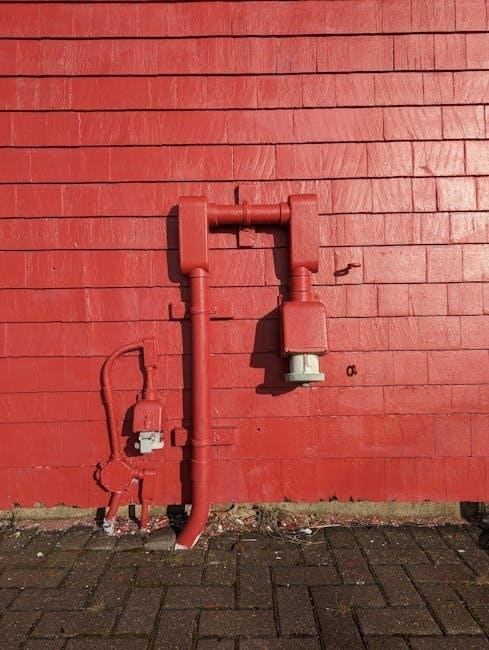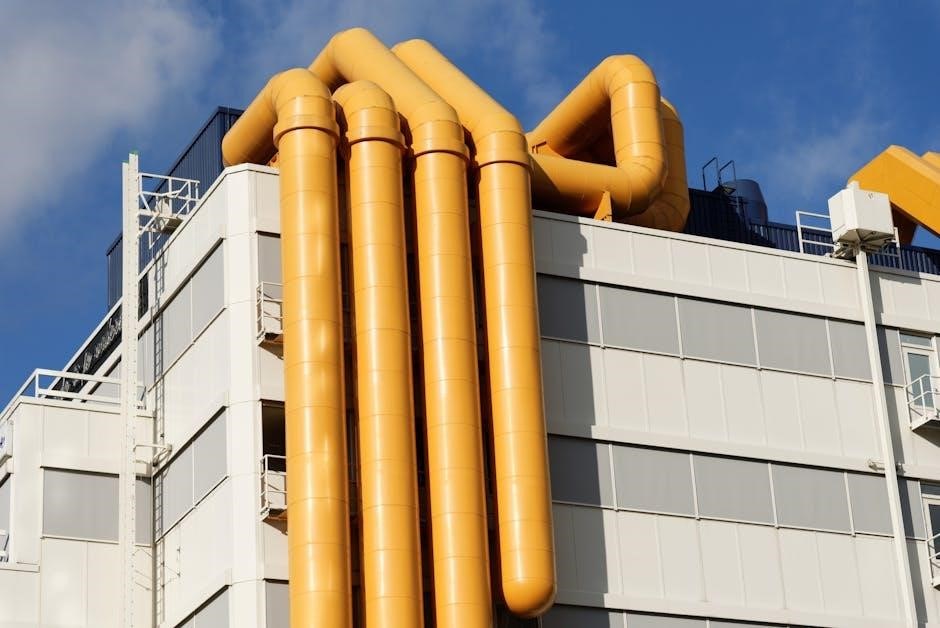
Industrial piping color codes are essential for safely identifying pipe contents in facilities. The ANSI/ASME A13.1 standard provides a universal system using colors and labels to ensure clarity and compliance. These codes help workers quickly recognize hazards, preventing accidents and maintaining operational efficiency. Safety and regulatory compliance are prioritized through standardized color schemes and labeling practices.
Overview of Pipe Identification Standards
Pipe identification standards ensure clear communication of pipe contents through colors and labels. The ANSI/ASME A13.1 standard is widely adopted, providing guidelines for color coding, label sizes, and placement. Six standard color combinations identify hazards like flammable or oxidizing fluids, while four user-defined combinations allow customization. These standards align with safety regulations, ensuring consistency and compliance across industries. Proper identification enhances worker safety, reduces errors, and streamlines operational efficiency in industrial settings.

History and Evolution of ANSI/ASME A13.1 Standard
The ANSI/ASME A13.1 standard has evolved significantly, with key revisions in 2007 and 2020. These updates refined color coding, introduced new safety alignments, and enhanced clarity for industrial piping systems.
Key Revisions in the 2007 Update
The 2007 revision of ANSI/ASME A13.1 introduced significant changes, including the removal of terms like “inherently hazardous” and the adoption of new color combinations. Yellow/Black was assigned to flammable and oxidizing fluids, while Green/White identified potable water. These updates streamlined the system, enhancing clarity and safety. The revision also emphasized consistency, ensuring uniform pipe labeling across industries. These changes were crucial for modernizing the standard and improving hazard communication in industrial settings.
Latest Updates in the 2020 Standard
The 2020 ANSI/ASME A13.1 standard introduced refined color schemes and updated labeling requirements. It now includes six standard color combinations and four user-defined options. The revision emphasizes clarity and consistency, ensuring better hazard communication. Additionally, it aligns with ANSI Z535.1 for safety colors, enhancing visual recognition. These updates reflect advancements in safety standards and industry needs, providing a more robust framework for pipe identification in modern facilities. Compliance with these updates is critical for maintaining workplace safety and regulatory adherence.

Understanding the Color Coding System
The color coding system uses specific combinations to identify pipe contents and hazards. Standard colors like yellow/black for flammable fluids and green/white for water ensure quick recognition, enhancing workplace safety and compliance with regulations.
Standard Color Combinations for Pipe Identification
The ANSI/ASME A13.1 standard defines specific color combinations for pipe identification. Yellow/Black indicates flammable or oxidizing fluids, while Green/White marks potable water, cooling, or boiler feed systems. Red/White is reserved for fire suppression, and Blue/White for compressed air. Orange/Black denotes corrosive materials, and Purple/White identifies chemicals. These standardized combinations ensure quick hazard recognition, preventing accidents and ensuring safety in industrial environments.
Predefined and User-Defined Color Schemes
ANSI/ASME A13.1 offers six predefined color combinations for common fluid types, ensuring consistency across industries. Additionally, four user-defined color schemes allow customization for specific applications. These predefined colors, like Yellow/Black for flammable fluids, enhance safety and compliance. Customizable options enable tailored solutions, accommodating unique industrial needs while maintaining adherence to the standard. This balance ensures effective communication and adaptability in diverse piping systems.
Design and Placement of Pipe Labels
ANSI/ASME A13.1 specifies guidelines for pipe label design and placement, ensuring visibility and compliance. Labels must be durable, legible, and appropriately sized based on pipe diameter. Placement should be consistent, avoiding obstructions, to facilitate quick identification. Proper design and positioning enhance safety, operational efficiency, and regulatory adherence in industrial settings.
Size Recommendations for Pipe Markers
The ANSI/ASME A13.1 standard provides specific size guidelines for pipe markers based on pipe diameter. The smallest markers are recommended for pipes under 2 inches, with letter heights of at least 1/2 inch. For larger pipes, marker sizes and letter heights increase proportionally to ensure visibility and readability. A size chart is included in the standard to help facilities comply with these requirements effectively.
Proper sizing ensures that pipe markers are easily visible, even from a distance, enhancing safety and operational efficiency. Compliance with these size recommendations is crucial for maintaining a safe working environment and meeting regulatory standards.
Letter Height and Color Field Requirements
The ANSI/ASME A13.1 standard specifies that letter height and color field dimensions must correlate with pipe size for optimal visibility. For pipes under 2 inches in diameter, a minimum letter height of 1/2 inch is required, while larger pipes demand proportionally larger lettering. The color field must clearly contrast with the pipe’s surface, ensuring immediate recognition of hazards. These requirements ensure consistency, readability, and compliance with safety standards across industrial facilities.
Compliance with Safety Standards
Adherence to safety standards like ANSI Z535.1 and OSHA regulations is crucial for industrial piping systems. Proper color coding ensures hazard communication, safeguarding employees and facilities from potential risks.
Alignment with ANSI Z535.1 for Safety Colors
The ANSI/ASME A13.1 standard aligns with ANSI Z535.1, ensuring consistent safety color codes. This alignment standardizes hazard communication, reducing confusion and enhancing safety. Color schemes like yellow/black for flammable fluids and green/white for water are universally recognized. Compliance with these standards ensures uniform pipe labeling across industries, facilitating quick hazard identification and improving workplace safety. This alignment also supports regulatory compliance and employee training, ensuring a safer working environment.
OSHA Requirements for Pipe Labeling
OSHA mandates clear pipe labeling to ensure workplace safety and hazard communication. The ANSI/ASME A13.1 standard, referenced by OSHA, requires pipes to be labeled with color codes and text. Labels must be durable, visible, and legible, detailing pipe contents and hazards. Compliance ensures quick identification of potential risks, preventing accidents. OSHA enforcement emphasizes proper labeling to safeguard workers and maintain a safe industrial environment, aligning with broader safety regulations and practices.
Materials and Durability of Pipe Markers
Pipe markers must be made from durable materials like PVC or polyester to withstand harsh industrial conditions. They must resist chemicals, UV, and extreme temperatures, ensuring longevity and clear visibility for safety compliance.
Recommended Materials for Industrial Environments
Pipe markers in industrial settings should be made from durable materials like PVC, polyester, or vinyl to withstand harsh conditions. These materials resist chemicals, UV exposure, and extreme temperatures, ensuring longevity. Bold colors and clear text must remain visible over time, adhering to safety standards. UV-resistant inks and laminated surfaces enhance durability, while adhesive-backed markers ensure secure attachment to pipes. Compliance with ANSI/ASME standards is crucial for maintaining safety and consistency across facilities.
Ensuring Longevity in Harsh Conditions
To ensure pipe markers withstand harsh environments, use materials resistant to chemicals, moisture, and abrasion. Laminated or encapsulated labels protect against UV exposure and physical wear. High-performance adhesives prevent peeling, even in extreme temperatures. Regular maintenance and inspections are crucial to maintain marker visibility and integrity. Durable printing methods and fade-resistant inks ensure colors remain vibrant, providing consistent identification over time. This ensures compliance with safety standards and clear communication in industrial settings.

User-Defined Color Combinations
Beyond standard codes, user-defined color combinations allow customization for unique applications. These four flexible options extend identification capabilities while maintaining safety and compliance with ANSI/ASME A13.1 guidelines.
Customizing Pipe Markers for Specific Applications
Customizing pipe markers allows industries to tailor identification systems to their unique needs. While ANSI/ASME A13.1 provides standard color codes, user-defined combinations enable flexibility for specific fluids or processes. These four customizable options complement the six standard color schemes, ensuring clarity in complex systems. Facilities can design markers to address unique hazards or substances, enhancing safety and efficiency. Customization must still adhere to durability and visibility standards for industrial environments.
Best Practices for User-Defined Systems
Adhering to best practices ensures user-defined pipe marking systems are effective and compliant. Standardization within a facility is crucial to avoid confusion. Documenting custom color schemes and communicating them to all employees enhances consistency. Regular audits and training help maintain compliance, while incorporating feedback from staff ensures practicality. Aligning with ANSI/ASME A13.1 guidelines for size, color, and placement guarantees that custom systems remain clear and safe, even in complex environments.

Secondary Means of Pipe Identification
Secondary pipe identification methods, like additional markings or textual labels, supplement color codes. These systems ensure consistency, enhance safety, and maintain compliance with industrial standards.
Supplementing Color Codes with Additional Markings
Additional markings enhance pipe identification by providing more detailed information. Text labels, symbols, and arrows are commonly used to supplement color codes. These markings clarify pipe contents, flow direction, and hazards, ensuring compliance with ANSI/ASME standards. Combining color codes with textual labels improves readability and safety, especially in complex piping systems. This dual approach ensures quick and accurate identification of pipe contents by workers.
Combining Color Codes with Textual Labels
Combining color codes with textual labels enhances pipe identification clarity. ANSI/ASME A13.1 recommends using both methods for optimal safety. Textual labels provide specific details about pipe contents, flow direction, and hazard levels, while color codes offer quick visual cues. This dual system ensures rapid and accurate identification, reducing errors and improving workplace safety. Consistency in labeling is crucial for compliance and easy understanding across facilities.

International Standards and Comparisons
Global standards like BS 1710 and ISO 14726 align with ANSI/ASME A13.1, ensuring international consistency in pipe identification. These standards promote safety and clarity across borders, facilitating uniform practices worldwide.
Comparison with BS 1710 and ISO 14726
While ANSI/ASME A13.1 is widely adopted in the U.S., BS 1710 and ISO 14726 offer similar frameworks globally. BS 1710 provides detailed color codes for pipe identification in the UK, aligning with ANSI’s principles. ISO 14726 extends these standards internationally, ensuring consistency across borders. Both systems emphasize hazard communication through color schemes, though specific codes may vary. These standards collectively enhance safety and clarity in industrial piping systems worldwide.
Global Applications of Pipe Color Coding
Pipe color coding is widely adopted globally to enhance workplace safety. International standards like ISO 14726 and regional codes such as BS 1710 ensure consistency. Industries worldwide, from oil and gas to power generation, rely on these systems for hazard communication. Global harmonization of pipe marking practices facilitates easier training and compliance across borders, ensuring that workers universally understand pipe contents and associated risks. This fosters a safer and more efficient industrial environment globally.
Training and Compliance
Training ensures consistency in pipe labeling, enabling employees to recognize hazards quickly. Compliance with ANSI/ASME standards is crucial for workplace safety and regulatory adherence.
Importance of Employee Training
Employee training is critical for ensuring safety and compliance with pipe labeling standards. Proper training helps workers understand color codes, enabling quick identification of hazards. This reduces accidents and ensures operational efficiency. Regular updates on ANSI/ASME A13.1 standards are essential for maintaining a safety-focused environment. Consistent training across departments guarantees uniformity in pipe labeling practices, enhancing overall facility safety and adherence to regulatory requirements.
Ensuring Consistency Across Facilities
Consistency in pipe labeling across facilities is crucial for safety and compliance. Adhering to the ANSI/ASME A13.1 standard ensures uniform identification of pipe contents. Regular audits and training help maintain consistency. Using standardized color codes and label sizes across all locations prevents confusion. This uniformity is vital for emergency response and maintenance efficiency, ensuring all staff can quickly identify pipe contents regardless of location.

Applications in Various Industries
Industrial piping color codes are widely used in oil, gas, chemical plants, and power generation. They are also applied in HVAC systems and large-scale industrial facilities. Consistent and accurate pipe labeling ensures safety and efficiency across these sectors. Standardized color schemes help workers quickly identify pipe contents, reducing risks and improving operational performance. This system is vital for maintaining smooth workflows in diverse industrial environments.
Use in Oil, Gas, and Chemical Plants
In oil, gas, and chemical plants, industrial piping color codes are critical for safety and efficiency. The ANSI/ASME A13.1 standard ensures clear identification of hazardous materials, such as flammable liquids or toxic chemicals. Color-coded pipes enable workers to quickly recognize potential risks, preventing accidents. This system is particularly vital in high-stakes environments where rapid hazard recognition is essential for protecting personnel and equipment. Consistent labeling also aids in compliance with industry regulations and facilitates maintenance operations.
The use of standardized color schemes in these industries ensures uniformity across facilities. For example, yellow/black pipes may indicate flammable substances, while green/white pipes denote water or cooling systems. This clarity minimizes confusion and enhances operational safety. By adhering to these guidelines, oil, gas, and chemical plants can maintain a safe working environment and ensure efficient workflows. Proper pipe labeling is a cornerstone of industrial safety practices in these sectors.
Adoption in Power Generation and HVAC Systems
In power generation and HVAC systems, industrial piping color codes are vital for safe and efficient operations. The ANSI/ASME A13.1 standard ensures clear identification of substances like steam, water, and fuel. Color-coded pipes help workers quickly recognize contents, reducing risks and downtime. For example, yellow/black pipes may indicate hazardous materials, while green/white pipes denote water systems. This standardized approach enhances safety, compliance, and maintenance efficiency in these critical industries.

Challenges and Solutions
Industrial piping systems face challenges like complex layouts and inconsistent labeling. Solutions include adopting standardized color codes, regular audits, and employee training to ensure compliance and safety, enhancing overall efficiency and reducing risks.
Common Mistakes in Pipe Labeling
One of the most frequent errors in pipe labeling is the incorrect use of color codes, often due to misunderstanding the ANSI/ASME A13.1 standard. Many facilities fail to update their labeling systems according to the latest revisions, such as the 2007 and 2020 updates, leading to non-compliance with safety standards. Additionally, labels are sometimes placed improperly, making them hard to read or easily damaged. Consistency across all pipes is also a common issue, with some pipes lacking labels entirely or having outdated information. These mistakes can result in safety hazards, fines, and operational inefficiencies. Regular audits and employee training are essential to mitigate these issues and ensure all labels meet current regulations. Properly labeled pipes enhance workplace safety, streamline maintenance, and improve overall facility management. By adhering strictly to the guidelines and staying informed about updates, facilities can avoid these pitfalls and maintain a safe and compliant environment.
Addressing Complex Piping Systems
Complex piping systems present unique challenges for labeling and identification. In large facilities with numerous pipes, maintaining clarity is crucial. The ANSI/ASME A13.1 standard recommends using a combination of color codes and secondary labels to distinguish between different types of content. For intricate systems, additional measures such as directional arrows and supplementary text can enhance readability. Regular audits and digital tracking tools are also essential to ensure accuracy and compliance. This approach ensures that even the most complicated piping networks remain safe and well-maintained.
Industrial piping color codes are vital for safety, compliance, and operational efficiency. They ensure quick hazard identification and adherence to standards, safeguarding personnel and facilities while promoting future advancements.
The Role of Color Codes in Industrial Safety
Color codes play a crucial role in industrial safety by providing immediate visual communication of pipe contents. The ANSI/ASME A13.1 standard assigns specific colors to hazards, such as yellow/black for flammable fluids and green/white for water. These standardized codes enhance visibility, reduce errors, and ensure compliance with safety regulations. They also align with ANSI Z535.1 for consistent safety color schemes. Proper training on these codes is essential for employee safety and operational efficiency.
Future Developments in Pipe Identification Standards
Future advancements in pipe identification standards aim to enhance clarity and safety through technology integration. Digital tools, such as QR codes and augmented reality, may supplement traditional color codes. Sustainability-focused materials and smarter labeling systems are also being explored. The ANSI/ASME A13.1 standard will likely evolve to incorporate global harmonization and industry-specific needs, ensuring safer and more efficient piping systems. These updates will align with emerging technologies and regulatory demands.